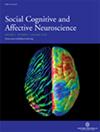社会支持与恐惧抑制:对潜在神经机制的研究
IF 3.1
2区 医学
Q2 NEUROSCIENCES
引用次数: 0
摘要
最近的研究表明,与我们最亲近的人的提醒对恐惧学习具有独特的综合效应,是一种新的恐惧抑制剂,被称为有准备的恐惧抑制剂。值得注意的是,社会支持形象已被证明不会与恐惧联系在一起,能抑制条件性恐惧反应,并导致长期的恐惧减少。由于这一类别的新颖性,人们对支持社会支持-提醒的这些独特能力的潜在神经机制的了解还有待研究。在这里,我们研究了使社会支持记忆在习得迟缓测试中不与恐惧相关联的神经相关因素。我们发现,社会支持图像(与陌生人图像相比)更不容易与恐惧联系在一起,这与之前的研究结果相同,而且这种效应与社会支持图像(与陌生人图像相比)的杏仁核活动减少和腹侧前额叶皮层(VMPFC)活动增加有关,这表明社会支持图像与 VMPFC 的联系以及由此产生的对杏仁核的抑制可能有助于产生独特的抑制作用。连通性分析也支持这一解释,分析结果显示,对于社会支持图像(与陌生人图像相比),VMPFC 和左侧杏仁核之间的连通性更高。本文章由计算机程序翻译,如有差异,请以英文原文为准。
Social Support and Fear-inhibition: An Examination of Underlying Neural Mechanisms
Recent work has demonstrated that reminders of those we are closest to have a unique combination of effects on fear learning and represent a new category of fear inhibitors, termed prepared fear suppressors. Notably, social-support-figure images have been shown to resist becoming associated with fear, suppress conditional-fear-responding, and lead to long-term fear reduction. Due to the novelty of this category, understanding the underlying neural mechanisms that support these unique abilities of social-support-reminders has yet to be investigated. Here, we examined the neural correlates that enable social-support-reminders to resist becoming associated with fear during a retardation-of-acquisition test. We found that social-support-figure-images (vs. stranger-images) were less readily associated with fear, replicating prior work, and that this effect was associated with decreased amygdala activity and increased ventromedial prefrontal cortex (VMPFC) activity for social-support-figure-images (vs. stranger-images), suggesting that social-support-engagement of the VMPFC and consequent inhibition of the amygdala may contribute to unique their inhibitory effects. Connectivity analyses supported this interpretation, showing greater connectivity between the VMPFC and left amygdala for social-support-figure-images (vs. stranger-images).
求助全文
通过发布文献求助,成功后即可免费获取论文全文。
去求助
来源期刊
CiteScore
6.80
自引率
4.80%
发文量
62
审稿时长
4-8 weeks
期刊介绍:
SCAN will consider research that uses neuroimaging (fMRI, MRI, PET, EEG, MEG), neuropsychological patient studies, animal lesion studies, single-cell recording, pharmacological perturbation, and transcranial magnetic stimulation. SCAN will also consider submissions that examine the mediational role of neural processes in linking social phenomena to physiological, neuroendocrine, immunological, developmental, and genetic processes. Additionally, SCAN will publish papers that address issues of mental and physical health as they relate to social and affective processes (e.g., autism, anxiety disorders, depression, stress, effects of child rearing) as long as cognitive neuroscience methods are used.

 求助内容:
求助内容: 应助结果提醒方式:
应助结果提醒方式:


